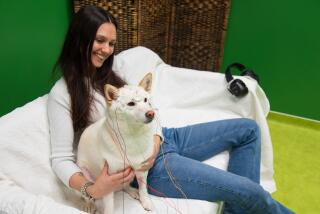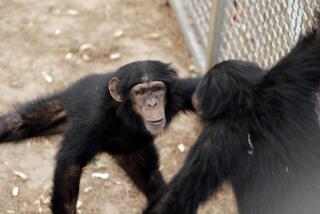Even bumblebees can learn to use tools, scientists show
Nevermind their loud, sleepy buzz â bumblebees are no drones. Scientists have discovered that these nectar-hunting insects actually can learn to use a new tool by watching others.
The findings, described in the journal Science, add to a growing body of work showing that these kinds of smarts arenât limited to bigger-brained, vertebrate animals (such as humans).
âIt is a nice confirmation that this level of cognitive complexity is possible in something as simple as a bee,â said James Nieh, a behavioral ecologist at UC San Diego who was not involved in the work.
Social insects like bees, ants and termites often get a lot of credit for collectively acting like super-organisms, guided by what some have dubbed âswarm intelligence.â Individual insects in the colony, however, havenât exactly been considered Mensa material.
The idea is based on an assumption that these insects are limited to a fairly small set of behaviors, and out of the decisions of many individual insects emerges the apparent collective intelligence. Scientists are interested in studying the rules underlying those behaviors so they can make cooperative robots, including termite-inspired builders that could be sent to disaster zones.

As part of a training session, a plastic bee is used to demonstrate to a real bee how to move a ball to the center of a ring. Once the ball is in the center of the ring, the bees are rewarded with sugar water.
Recent experiments, however, have shown that even as individuals, these supposedly simple animals are capable of far more than previously imagined. Bees have been shown to perform a wide range of cognitive tasks involving counting, concept learning and social learning.
But many of these jobs have analogues in their natural foraging routines. A better test, the authors wrote, would be to test whether these bees can pick up a task thatâs different from their normal routine.
For this paper, co-lead author Olli Loukola, a behavioral ecologist at Queen Mary University of London, and his colleagues placed bumblebees well outside of their natural comfort zone, in an arena resembling a single hole in bee-sized mini-golf. The goal: Get a yellow ball into the hole in the center of the platform and be rewarded with a sugar solution. The scientists used a fake bee mounted on a transparent stick to show the insects what to do. Over 10 rounds, the bees finished the task faster and more efficiently, taking shorter paths to get the ball to its goal.

After watching another bee roll a ball, this bee successfully mimics the behavior to retrieve the reward for itself.
In the next iteration of the experiment, scientists placed three yellow balls in the arena and glued down the two closest to the center. Then they divided the bees into three groups. Some were allowed to watch a previously trained bee move the farthest ball (the only one not glued in place) to the hole and get its sweet reward. Others saw the ball move to the center in a ghostly fashion (pulled by a magnet beneath the platform) before getting the sweet treat. In the third group, the bees saw no demonstration â they simply encountered the ball already in the center with the sugar solution available.
Next came the real test: to see what the novice bees had learned. Researchers put the bumblebees into the arena with three balls. None was glued down this time, but the ball closest to the hole was black instead of yellow.
As it turned out, the bees who watched an expert successfully made a hole-in-one in 99% of their trials and took the least time to do it â an average of 47 seconds. Those who saw the âghostâ demonstration got it right about 78% of the time and took 84 seconds, while those with no demonstration fared far worse, figuring it out only 34% of the time and in roughly 96 seconds.
The bees had learned this random task with an unfamiliar tool â neither the job nor the ball has anything to do with their normal behaviors â just by watching the ball move. They picked up the action quicker and faster after watching an expert at work.
But the novice bees didnât mimic their teachers directly. Even though the expert bees moved only the farthest, yellow ball, the novices tended to go for the black ball closest to the hole. (The bees in the first experiment also preferred to pull the ball backward toward the center, even though they saw the fake bee-on-a-stick push it forward.)
These tiny insects took a winning strategy and improved it, instead of mindlessly mimicking it.
âBees did not simply copy the behavior of the demonstrator but rather improved on the observed behavior by using a more optimal route,â the study authors wrote. âThat bees solved this novel, complex goal-directed problem â and solved it via observation and using a better strategy than originally demonstrated â shows an unprecedented degree of behavioral flexibility in an insect.â
These advanced learning abilities could, evolutionarily speaking, come in handy when social insects encounter new ecological pressures during environmental change, scientists said.
âI think that animals are much more clever in their own way than we often give them credit for, at least in scientific publications,â Nieh said.
Of course, Nieh added, itâs possible this is a particular trait in bumblebees and not in other species, such as honeybees. Among many differences, bumblebees are more independent foragers; they search for nectar on their own rather than recruiting other bees.
So one of the next steps, he said, could be to try to repeat this experiment with other bee species, to determine whether they also can learn new tricks from one another. This might be harder to pull off, as some species require larger flight cages and often spend much of their time trying to escape. Bumblebees need smaller flight cages and tend to settle down more quickly.
In recent years, scientists have begun looking at the brains of insects â how they process so much with such little headspace â for insight into building smarter computers. The bumblebee, it seems, could offer a few pointers.
âThe way that data is stored on a computer chip and recalled is very different from a brain, but in terms of what it can do in the real world, I think we actually can learn a lot from animal brains,â Nieh said.
Follow @aminawrite on Twitter for more science news and âlikeâ Los Angeles Times Science & Health on Facebook.
MORE IN SCIENCE
Can a mouse meditate? Why these researchers want to find out
African penguins are being âtrappedâ by climate change







